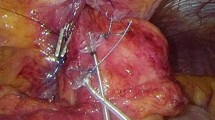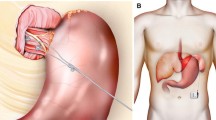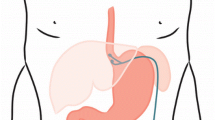Abstract
Background
Electrical stimulation therapy (EST) has been shown to increase lower esophageal sphincter (LES) pressure in animals; however, data on the effect of EST on LES pressure in patients with gastroesophageal reflux disease (GERD) are lacking.
Objective
The aim of our study was to investigate the effect of EST on LES pressure and esophageal function in patients with GERD.
Methods
Patients with a diagnosis of GERD responsive to proton pump inhibitors (PPIs), increased esophageal acid on 24-h pH monitoring off GERD medications, basal LES pressure >5 mmHg, hernia <2 cm and esophagitis <LA grade B were included. A temporary pacemaker lead was placed endoscopically in the LES by creating a 3 cm submucosal tunnel, secured to the esophagus using endoscopic clips along the body of the lead and exteriorized nasally. EST was delivered 6–12 h post-implant per protocol using (i) short-pulse 200 μs, 20 Hz, and (ii) intermediate-pulse 3 ms, 20 Hz, each for 20 min at varying amplitudes. High-resolution manometry was performed pre-, during and post-EST. Symptoms of heartburn, chest or abdominal pain and dysphagia pre-, during and post-stimulation and 7 days post-procedure were recorded. Continuous cardiac monitoring was performed during and after the EST to evaluate any effect of EST on cardiac rhythm.
Results
Six male patients (mean age 34.6 years) underwent successful endoscopic lead implantation; the first patient had premature lead dislodgement and did not undergo EST. The remaining five patients underwent successful EST. All patients had a significant increase in LES pressure with all sessions of EST. There was no effect on swallow-induced LES relaxation, And there were no EST-related adverse symptoms or any cardiac rhythm abnormalities.
Conclusions
In patients with GERD, short-term EST delivered using electrodes endoscopically implanted in the LES results in a significant increase in LES pressure without affecting patients’ swallow function or causing any adverse symptoms or cardiac rhythm disturbances. EST may offer a novel therapy to patients with GERD.




Similar content being viewed by others
References
Sandler RS, Everhart JE, Donowitz M et al (2002) The burden of selected digestive diseases in the United States. Gastroenterology 122:1500–1511
American Gastroenterological Association. GERD patient study: patients and their medications. Harris Interactive Inc; 2008
Sidhu AS, Triadafilopoulos G (2008) Neuro-regulation of lower esophageal sphincter function as treatment for gastroesophageal reflux disease. World J Gastroenterol 14:985–990
Rothstein RI (2008) Endoscopic therapy of gastroesophageal reflux disease outcomes of the randomized-controlled trials done to date. J Clin Gastroenterol 42:594–602
Sanmiguel CP, Hagiike M, Mintchev MP et al (2008) Effect of electrical stimulation of the LES on LES pressure in a canine model. Am J Physiol Gastrointest Liver Physiol 295:389–394
Clarke JO, Jagannath SB, Kalloo AN et al (2007) An endoscopically implantable device stimulates the lower esophageal sphincter on demand by remote control: a study using a canine model. Endoscopy 39:72–76
Spechler SJ, Lee E, Ahnen D et al (2001) Long-term outcome of medical and surgical therapies for gastroesophageal reflux disease: follow-up of a randomized controlled trial. JAMA 285:2331–2338
Cadière GB, Van Sante N, Graves JE, Gawlicka AK, Rajan A (2009) Two-year results of a feasibility study on antireflux transoral incisionless fundoplication using EsophyX. Surg Endosc 23(5):957–964
Bonavina L, DeMeester T, Fockens P et al (2010) Laparoscopic sphincter augmentation device eliminates reflux symptoms and normalizes esophageal acid exposure: one- and 2-year results of a feasibility trial. Ann Surg 252(5):857–862
Ellis F, Berne TV, Settevig K (1968) The prevention of experimentally induced reflux by electrical stimulation of the distal esophagus. Am J Surg 111:482–487
McCallum RW, Snape W, Brody F, Wo J, Parkman HP, Nowak T (2010) Gastric electrical stimulation with Enterra therapy improves symptoms from diabetic gastroparesis in a prospective study. Clin Gastroenterol Hepatol 8:947–954
Frobert O, Arendt-Nielsen L, Bak P, Funch-Jensen P, Bagger JP (1996) Pain perception and brain evoked potentials in patients with angina despite normal coronary angiograms. Heart 75:436–441
Frobert O, Arendt-Nielsen L, Bak P, Funch-Jensen P, Bagger JP (1995) Oesophageal sensation assessed by electrical stimuli and brain evoked potentials: a new model for visceral nociception. Gut 37:603–609
Rodríguez L, Rodriguez P, Netto MG et al (2012) Short term electrical stimulation of the lower esophageal sphincter increases sphincter pressure in patients with gastroesophageal reflux disease. Neurogastro Motil 24:446–450
Rodríguez L, Rodriguez P, Gómez B et al (2013) Long-term results of electrical stimulation of the lower esophageal sphincter for the treatment of gastroesophageal reflux disease. Endoscopy 45:595–604
Gastroenterology in Asia Pacific: excellence in the new decade [oral abstracts] 2010 J Gastroenterol Hepatol 25 Suppl. 2:A16
Disclosures
The results of this study were presented at the Asia Pacific Digestive Disease Week 2010, Kuala Lumpur, Indonesia, and have been published in abstract form [16]. The study was funded by a research grant from EndoStim, B.V., The Hague, The Netherlands. The authors have no conflicts of interest or financial ties to disclose.
Author information
Authors and Affiliations
Corresponding author
Rights and permissions
About this article
Cite this article
Banerjee, R., Pratap, N., Kalpala, R. et al. Effect of electrical stimulation of the lower esophageal sphincter using endoscopically implanted temporary stimulation leads in patients with reflux disease. Surg Endosc 28, 1003–1009 (2014). https://doi.org/10.1007/s00464-013-3271-2
Received:
Accepted:
Published:
Issue Date:
DOI: https://doi.org/10.1007/s00464-013-3271-2




